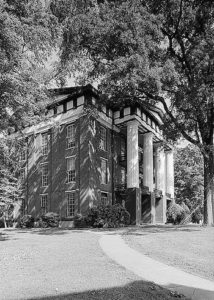
Swayne Hall
*Talladega College was founded on this date in 1865. It is a private Historically Black College (HBCU) in Talladega, Alabama, and Alabama's oldest private HBCU.
The Southern Association of Colleges and Schools accredits it. Talladega College's history began when three former slaves, William Savery, Thomas Tarrant, and Ambrose Headen of Talladega, met at the convention with a group of new freedmen in Mobile, Alabama.
From this meeting, "We regard the education of our children and youth as vital to the preservation of our liberties, and true religion as the foundation of all real virtue and shall use our utmost endeavors to promote these blessings in our common country."
With this as their pledge, Savery, Tarrant, and Headen, aided by General Wager Swayne of the Freedmen's Bureau, began to provide a school for the Black children of former community slaves. Their leadership resulted in constructing a one-room schoolhouse using lumber salvaged from an abandoned carpenter's shop. The school overflowed with pupils from its opening, and soon, it was necessary to move into larger quarters. Meanwhile, the nearby Coosa River Valley Baptist Academy was about to be sold under mortgage default. This building had been built in 1852 with the help of slaves, including Savery, Tarrant, and Headen. A request was sent to General Swayne for its purchase, and he persuaded the American Missionary Association to buy the building and some 20 acres (81,000 m2) of land for $23,000.
The grateful parents renamed the Swayne School building, which opened in November 1867 with about 140 pupils. A building constructed before the war with slave labor for white students became the home of the state's first college dedicated to serving the educational needs of Blacks. In 1869, Swayne School was issued a charter as Talladega College by the Judge of Probate of Talladega County. The former Baptist Academy building, now known as Swayne Hall (pictured), has remained in service as the symbol and spirit of the beginning of the college. Talladega College campus consists of 50 acres (200,000 m2) with 17 primary buildings. Thirty-two campus buildings are listed on the National Register of Historic Places as the Talladega College Historic District.
The Savery Library, completed in 1939, was built to replace a 1907 structure built with a donation from Andrew Carnegie. The library houses hundreds of thousands of serials, a Record Room, a fully equipped computer laboratory, a unique Archives Room, and the historic Amistad murals painted by Hale Woodruff. Embedded on the library floor is a mural of La Amistad, which school tradition says must never be stepped upon, referring to the mutiny by slaves, who took control of that ship and later won their freedom in a United States court, is depicted upon the surrounding walls.
The mezzanine floor of the library houses the Galangue Room. This room contains an extensive collection of Angolan and Nigerian artifacts. Built in 1910, Andrews Hall houses the Music and Education Department. It is named for George Whitfield Andrews, D.D., Dean of the Theological Department, from 1875 to 1908. Arthur D. Shores Hall, constructed in 1974, is named for the late attorney Arthur D. Shores, Class of 1927, who served many years as a member and chairman of the College Board of Trustees.
DeForest Chapel was built in 1903 to commemorate the life and service of the Rev. Henry Swift De Forest, D.D., President of the College from 1879 to 1896; it was renovated and rededicated in November 1996. Fanning Refectory was built in 1928 from the legacy of Dr. David H. Fanning of Worcester, Massachusetts. The building contains the student and faculty dining rooms. Juliette Derricotte House, built in 1940-41, was the gift of the Harkness Foundation and named for Juliette Derricotte, Class of 1918. Formerly a staff residence and guest house, it was converted into a women's honors dormitory in 1988. Silsby Science Hall, constructed in 1926, was named for Dr. E. C. Silsby. The building was a gift from the General Education Board, friends, and college alumni. It contains laboratories and classrooms for the Natural Sciences and Mathematics.
Talladega College athletic teams, nicknamed the Tornadoes, are part of the National Association of Intercollegiate Athletics (NAIA) Division II level, primarily competing in the Gulf Coast Athletic Conference (GCAC). Men's sports include baseball, golf, and soccer, while women's sports include basketball, softball, and volleyball.
The Talladega College Tornado Marching Band (the Great Tornado) was established in 2012. The marching band is the largest organization on campus, with over 200 members. The marching band debuted at the annual Honda Battle of the Bands in 2015 and performed at the 2017 U.S. presidential inauguration parade in Washington, D.C. Notable Alumni include Cary Allen McCray and Theodore Lawless.
Black American Colleges and Universities:
Profiles of Two-Year, Four-Year, & Professional Schools
by Levin Hill, Pub., Gale Group, 1994
ISBN: 0-02-864984-2